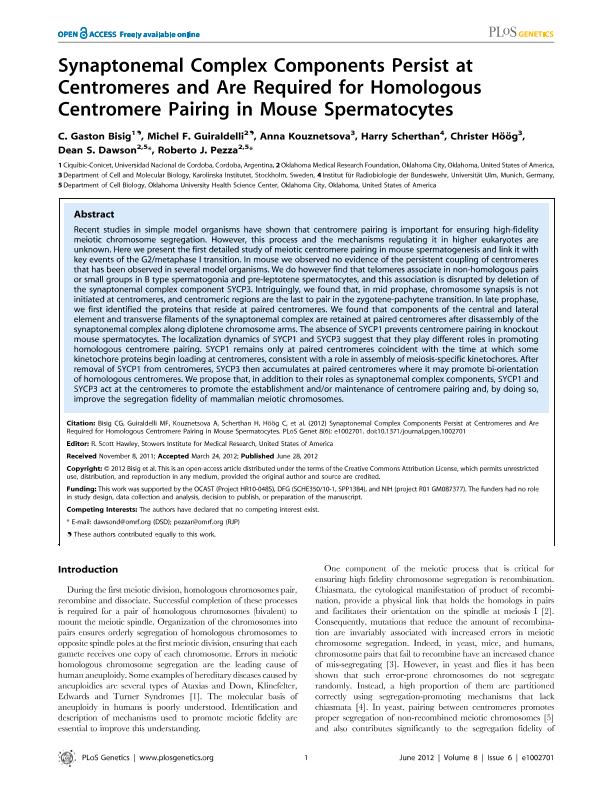Artículo
Synaptonemal complex components persist at centromeres and are required for homologous centromere pairing in mouse spermatocytes
Bisig, Carlos Gaston ; Guiraldelli, Michel F.; Kouznetsova, Anna; Scherthan, Harry; Höög, Christer; Dawson, Dean S.; Pezza, Roberto J.
; Guiraldelli, Michel F.; Kouznetsova, Anna; Scherthan, Harry; Höög, Christer; Dawson, Dean S.; Pezza, Roberto J.
 ; Guiraldelli, Michel F.; Kouznetsova, Anna; Scherthan, Harry; Höög, Christer; Dawson, Dean S.; Pezza, Roberto J.
; Guiraldelli, Michel F.; Kouznetsova, Anna; Scherthan, Harry; Höög, Christer; Dawson, Dean S.; Pezza, Roberto J.
Fecha de publicación:
28/06/2012
Editorial:
Public Library of Science
Revista:
Plos Genetics
ISSN:
1553-7390
e-ISSN:
1553-7404
Idioma:
Inglés
Tipo de recurso:
Artículo publicado
Clasificación temática:
Resumen
Recent studies in simple model organisms have shown that centromere pairing is important for ensuring high-fidelity meiotic chromosome segregation. However, this process and the mechanisms regulating it in higher eukaryotes are unknown. Here we present the first detailed study of meiotic centromere pairing in mouse spermatogenesis and link it with key events of the G2/metaphase I transition. In mouse we observed no evidence of the persistent coupling of centromeres that has been observed in several model organisms. We do however find that telomeres associate in non-homologous pairs or small groups in B type spermatogonia and pre-leptotene spermatocytes, and this association is disrupted by deletion of the synaptonemal complex component SYCP3. Intriguingly, we found that, in mid prophase, chromosome synapsis is not initiated at centromeres, and centromeric regions are the last to pair in the zygotene-pachytene transition. In late prophase, we first identified the proteins that reside at paired centromeres. We found that components of the central and lateral element and transverse filaments of the synaptonemal complex are retained at paired centromeres after disassembly of the synaptonemal complex along diplotene chromosome arms. The absence of SYCP1 prevents centromere pairing in knockout mouse spermatocytes. The localization dynamics of SYCP1 and SYCP3 suggest that they play different roles in promoting homologous centromere pairing. SYCP1 remains only at paired centromeres coincident with the time at which some kinetochore proteins begin loading at centromeres, consistent with a role in assembly of meiosis-specific kinetochores. After removal of SYCP1 from centromeres, SYCP3 then accumulates at paired centromeres where it may promote bi-orientation of homologous centromeres. We propose that, in addition to their roles as synaptonemal complex components, SYCP1 and SYCP3 act at the centromeres to promote the establishment and/or maintenance of centromere pairing and, by doing so, improve the segregation fidelity of mammalian meiotic chromosomes.
Palabras clave:
Synaptonemal Complex
,
Homologous Centromere Pairing
,
Spermatocytes
,
Tubulin
Archivos asociados
Licencia
Identificadores
Colecciones
Articulos(CIQUIBIC)
Articulos de CENTRO DE INVEST.EN QCA.BIOL.DE CORDOBA (P)
Articulos de CENTRO DE INVEST.EN QCA.BIOL.DE CORDOBA (P)
Citación
Bisig, Carlos Gaston; Guiraldelli, Michel F.; Kouznetsova, Anna; Scherthan, Harry; Höög, Christer; et al.; Synaptonemal complex components persist at centromeres and are required for homologous centromere pairing in mouse spermatocytes; Public Library of Science; Plos Genetics; 8; 6; 28-6-2012; 1-13
Compartir
Altmétricas



